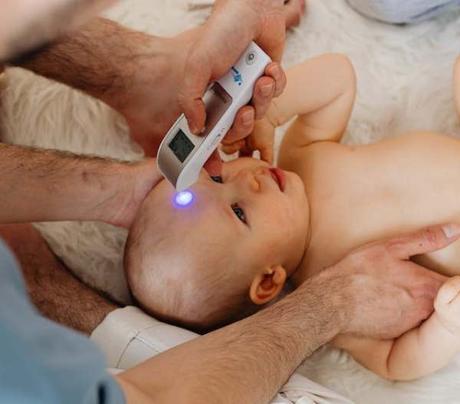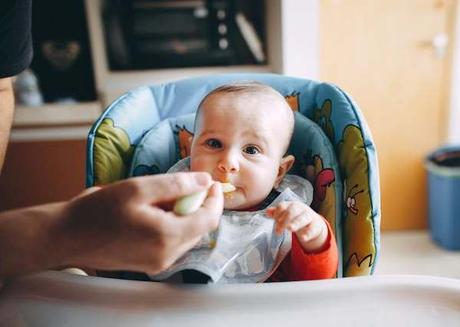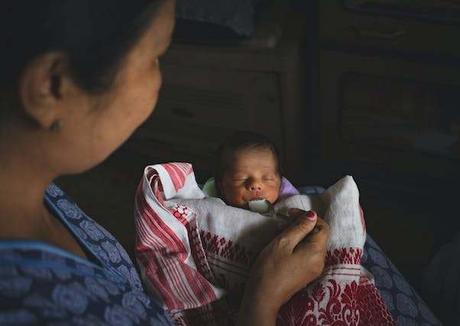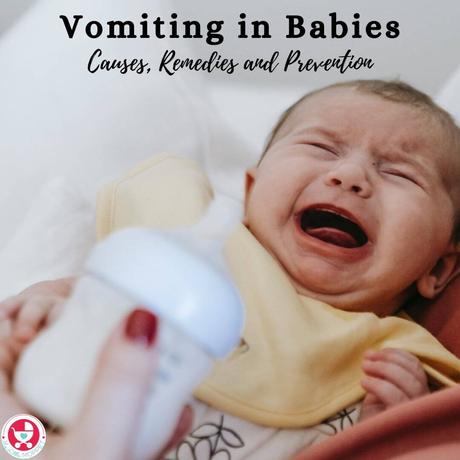Published: December 21, 2023 | Last Updated on: December 21, 2023 | by Hema
Vomiting in babies is common, but it can be scary. Let’s understand what causes it, along with ways to treat it as well as ways to prevent it.
Jump To hide Vomiting in Babies: Understand, Prevent & Treat Types of Vomiting in Babies Causes of Vomiting in Babies 1. GERD 2. Feeding Difficulty 3. Gastroenteritis 4. Cold and Flu 5. Ear Infection 6. Food Allergies 7. Overheating 8. Motion Sickness 9. Pyloric Stenosis 10. Intussusception Treatment for Vomiting in Babies Reduce the amount of feed Offer fluids Stop solid foods Avoid oral medication Make them comfortable How to Prevent Vomiting in Babies How to identify if the vomiting is serious References: Buy Healthy Nutritious Baby, Toddler food made by our own Doctor Mom !They say that one sign you’ve become a seasoned parent is when you can catch vomit with your bare hands. I’d add to this – the fact that you can read the previous sentence without balking is also a good sign!
Vomiting in babies and children is something every parent has to encounter on their parenting journey – multiple times! Children vomit for many reasons, and in most cases it isn’t anything serious, resolving on its own in a couple of days.


Vomiting is more frequent in the first 12 months of a child’s life, since their digestive system is still developing, and both the child and parents are figuring out how much food they need at each meal. However, sometimes, vomiting in babies can be a result of an underlying illness or medical complication, and it helps to stay informed of all possible causes.
Vomiting in Babies: Understand, Prevent & Treat

Vomiting is the general term used to describe the involuntary throwing up of food. Vomiting is uncomfortable and often forceful. Depending upon the way the food is brought up, there are different types of vomiting in babies.
Types of Vomiting in Babies
- Spit-up – This is when small amounts of milk are brought up after a feeding, usually when burping. this is often due to babies swallowing too fast, being overfed or swallowing too much air. This usually appears like a thin milky white liquid.
- Posseting/Reflux – This is similar to spit up but may contain some stomach juices, due to which the vomit appears more cheesy, like curdled milk. It occurs because the baby’s oesophageal sphincter is still underdeveloped. Posseting is common in the first few months and soon settles down.
- Projectile vomiting – This vomiting is the forceful kind, where the vomit may travel a distance before landing. This could be due to multiple reasons and can occur at any age.
If your baby seems happy, is gaining weight and has no other issues, the first two types of vomiting are not a cause for concern. They usually go away on their own, as baby’s digestive system develops. However, forceful vomiting requires more investigation, since there are many causes for it.
Causes of Vomiting in Babies

1. GERD
Like adults, some babies can also suffer from acid reflux, also known as gastroesophageal reflux disease or GERD). GERD is a more severe form of reflux, although the causes are related. GERD occurs due to esophagus muscles that aren’t strong enough to keep stomach contents down. In most cases, the baby’s stomach muscles strengthen and GERD goes away. In some cases, you may need medical treatment.
2. Feeding Difficulty
Breastfeeding may be something mothers need to learn, but guess what – babies also need to learn how to feed properly! Most young babies take time to learn how to suck and swallow, as well as to recognize when they’ve had enough. During this time, they are likely to bring up their milk often.
Once your baby figures these things out, usually within a couple of months, vomiting slows down and goes away. You can also aid the process by offering smaller feeds at more frequent intervals. If you’re bottle feeding, make sure the nipple’s hole isn’t too big. If you’re breastfeeding, oversupply is a common breastfeeding problem, and pumping can help.
3. Gastroenteritis
Also known as the stomach bug or stomach flu, gastroenteritis is one of the most common causes of vomiting in babies and children, according to the American Academy of Pediatrics (AAP). Stomach infections are usually due to viruses like rotaviruses, noroviruses, enteroviruses and adenoviruses, as well as bacteria like Salmonella, E coli, Shigella and Staphylococcus.
Vomiting is one of the symptoms of gastroenteritis, along with diarrhea, stomach pain and in some cases, fever. The vomiting may come in cycles and usually begins to settle down after 24 hours. Children generally recover from gastroenteritis in a week.

4. Cold and Flu
It isn’t just the stomach flu that can cause vomiting in babies – the regular flu can also do it! Since babies’ immune systems are still developing, they are more prone to catching colds and flu from people around them. While the common symptoms of a cold or flu are runny noses and fever, some babies may also have vomiting.
This can be due to a postnasal drip into the throat, caused by congestion in the nose. This can lead to coughing which when forceful, can trigger vomiting. Viral cases of flu usually go away on their own in a week, while bacterial infections may require antibiotics.
5. Ear Infection
Like the flu, ear infections are also common in babies and young children due to the structure of their ears. Young children’s ear tubes are horizontal, making them more prone to infection. When the inner ear is infected, there is a fluid buildup in the ears.
This buildup can affect balance and affect the body’s system that regulates perception. These effects can cause nausea and vomiting, along with other symptoms like pain, pulling at the ears and diarrhea. Most ear infections go away on their own, but prolonged ear infections can cause permanent damage.
6. Food Allergies
A study by the Children’s Hospital of Chicago found that 89% of food allergy symptoms in babies were stomach issues, while vomiting was seen in 83% of cases. Check out our post to know if your baby has a food allergy, so you can take steps to avoid it. Allergic symptoms are visible usually within minutes of eating the trigger food, so you can identify the culprits.
A more severe form of food allergy is galactosemia, a rare kind of milk intolerance seen in babies who don’t have the enzymes they need to break down milk sugars. This allergy causes nausea and vomiting on ingestion of any kind of dairy products and can be diagnosed via a blood test or urine test.

7. Overheating
This may seem like an unusual cause for vomiting in babies, but overheating is something many of us ignore when swaddling our babies in multiple layers. Babies’ bodies are not fully capable of sweating out excess heat, which means they are more vulnerable to overheating. Overheating can cause vomiting, along with dehydration and exhaustion.
If you notice overheating, immediately remove items of clothing, and hydrate your baby. Always dress babies according to the weather, and add or remove layers as required.
8. Motion Sickness
Motion sickness is uncommon in children under 2 years of age, but it can still occur, especially if your baby has just been moved a lot right after eating. This is particularly true if they’re already gassy, bloated or constipated. You can prevent this by traveling when the baby is asleep, offering enough support to minimize movement and avoiding travel right after a feed.
9. Pyloric Stenosis
This is a serious and rare condition where the pylorus, the opening between the stomach and intestines, is too narrow or blocked partially or completely. It presents as forceful vomiting after feeding, along with weight loss and dehydration. This is observed in babies under 3 months and needs corrective surgery.
10. Intussusception
Intussusception is an extremely rare condition, affecting 1 in 1200 babies. It happens when the intestines are damaged and one part of the intestine slides into another. It is generally seen in babies 3 months or older and presents with symptoms like vomiting, fatigue, stomach cramps, and blood or mucus in bowel movements. Intussusception requires surgery to fix the intestines, which will get rid of all other symptoms.
Besides these, many other medical conditions can cause unexplained vomiting in babies, like kidney disease or a strangulated hernia. If you notice anything out of the ordinary, it is best to consult your child’s pediatrician, who will guide you toward the right course of treatment.
Treatment for Vomiting in Babies
Most of the cases of vomiting in babies are self-resolving, and don’t require medicines, just a few home remedies that can ease baby’s comfort and prevent dehydration.

Reduce the amount of feed
Yes, you have to watch out for dehydration in your baby, but the best way to ensure that any fluid that goes in stays in is by feeding smaller amounts at regular intervals.
If breastfeeding, nurse for just 5 minutes every half an hour. If the baby can hold it down for at least four hours, nurse for about 10 minutes every hour. If the baby does not vomit, continue this till you go back to your usual feeding schedule.
However, if your baby can’t hold down anything for four hours, pump some milk and use a syringe to feed just 5-10 ml every 5 minutes. Continue this till baby can hold down his milk for four hours, and you can go back to feeding directly from the breast.
If your child is bottle-fed pumped breast milk, offer half the usual amount every hour. If he continues to vomit, reduce it to 3o ml every half an hour or as low as 5-10 ml every 5 minutes. Once your baby can hold down his milk for at least four hours, you can slowly increase the amount till you reach your usual schedule.
ORS is generally not recommended for exclusively breastfed babies, but if your baby completely rejects breast milk, you may have to consider it.
Offer fluids
Fluids are what’s recommended the most during vomiting since dehydration is the biggest risk for babies and young children. Breastfeeding is the best way out, or if you’re formula-feeding, offer small amounts of formula at frequent intervals.
If your baby can’t keep any milk down, you can offer an oral rehydration solution, also called ORS. Give baby 5-10 ml of ORS every 5 minutes. Once the baby can hold that down, offer double the amount every 5-10 minutes. When baby can go without vomiting for 8 hours, you can go back to milk.

Stop solid foods
If your baby has started weaning, it may be wise to stop solids for now and stick to liquids since they are less likely to trigger a bout of vomiting. The American Academy of Pediatrics (AAP) suggests skipping solids for 24 hours. When restarting solid foods, start with small amounts, like a few teaspoons.
After a session of vomiting, always start with easily digestible foods, like the BRAT diet – bananas, rice, applesauce and toast. These foods are neutral and easy on the stomach.
Avoid oral medication
It is best to avoid any kind of oral medications during vomiting in babies. Many medicines can irritate the stomach and make vomiting worse. Stopping all medicines for just 8 hours can give the stomach a chance to heal and go back to normal. If you need to administer medication for something like high fever, opt for a suppository formulation.
Make them comfortable
Vomiting can make even adults feel tired and uncomfortable, so imagine how babies must feel! Do whatever you can to keep your child comfortable, and help them sleep as much as they can, so they can conserve their energy and get rest. Let your baby lie down on their side so they don’t accidentally inhale vomit into her lungs.

How to Prevent Vomiting in Babies
- Don’t overfeed, and offer smaller amounts of food at frequent intervals
- If bottle feeding, make sure the nipple hole is just the right size
- Burp baby often to get rid of any gas, both between and after feeding
- Keep baby in an upright position after feeding, for about half an hour
- Avoid bouncing or vigorous play right after feeding, at least for 20 minutes
- Keep mealtimes calm and undisturbed, so baby can feed slowly
- Maintain proper hand hygiene at all times, especially after cooking or using the bathroom
- Keep baby away from anyone with a stomach infection
- If someone in the family has an infection, make sure there is no sharing of food or other items
How to identify if the vomiting is serious
Since we know that there are different types of vomiting and only some are serious, it can be confusing for new parents to know what to do when their baby vomits for the first time. You need to watch out for how often your baby vomits.
Most babies vomit continuously for 3-4 hours, after which things settle down. A viral infection generally comes down in a day, while mild symptoms may last up to 3 days. Here is how you can classify mild to severe vomiting:
- Mild: Vomits 1-2 times a day
- Moderate: Vomits 3-7 times a day
- Severe: Vomits almost everything 8 or more times a day
The biggest risk with vomiting in babies is dehydration since the body loses fluids through vomit. This is particularly true for infants and small children, who can get dehydrated quickly. Here are the signs of dehydration in babies:
- Dark yellow urine
- Dry diapers – no urine in over 8 hours
- Dry mouth and tongue
- Lack of tears when crying
- Drowsiness
Besides signs of dehydration, rush your child to the doctor if you notice any of these symptoms along with vomiting:
- Diarrhea
- Bloody stools
- Non-stop vomiting for 8 hours
- Inability to hold anything down, including ORS
- Severe stomach pain
- Swollen or bloated stomach
- Head injury in the last 24 hours
- High temperature
- Stiff neck
- Skin rashes
- Blood in the vomit
- Green or yellowish-green vomit
- Vomit that looks like coffee grounds
- Pain when looking at bright lights
- Forceful cough
- Lethargy, not smiling
If you suspect your child may have swallowed something toxic, rush to the emergency right away. Your doctor will most likely ask when the vomiting started, how often the child is vomiting, how much they are vomiting, what the vomit looks like, and whether it is forceful.
Make sure you have the answers to these questions, as they can help the doctor identify the exact cause. Your doctor may prescribe an imaging test or blood test to confirm the diagnosis and start treatment.

References:
Buy Healthy Nutritious Baby, Toddler food made by our own Doctor Mom !
Shop now!You may also like
- Oral Thrush in Babies - Causes, Cure and Prevention

- 7 Easy Ways for Cold and Flu Prevention this Season

- Top 10 Effective Home Remedies for Diarrhea in…

- Top 10 Natural Home Remedies for Teething Babies

- Home Remedies for Dry Cough in Babies and Kids

- Understanding and Treating Urinary Tract Infections…

Filed Under: Baby, Baby health
